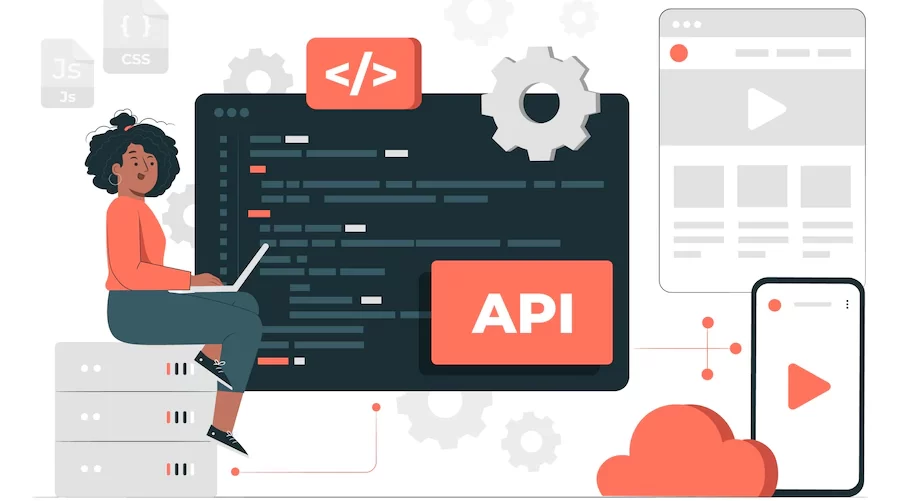Application programming interfaces, or APIs, allow businesses to make their applications’ data and functionality available to internal company departments, external third-party developers, and business partners. This allows products and services to interact with one another and use one another’s data and capabilities via a specified interface.
Programmers simply use the interface to communicate with other applications and services; they are not required to comprehend how a country API is executed. Over the last ten years, the use of APIs has grown to such an extent that many of today’s most important web applications would not be possible without them.
What Exactly does API stand for?
API stands for Application Programming Interface. When describing APIs, any software with a particular function is called an application. Interfaces are analogous to a provider contract between two software programs. This document states the web requests that will be used to interact between two or more parties. Developers can find details on selecting those API calls in their Web applications.
Types of APIs:
There are various APIs, each serving specific purposes and catering to different use cases. Some common types of APIs include:
- Web APIs: These are designed to be accessed over the internet using HTTP protocols. Web APIs enable developers to access functionalities and data from remote servers, often using standard formats like JSON or XML for data interchange.
- Operating System APIs: Operating system APIs provide developers with interfaces to interact with the underlying operating system functionalities. These APIs facilitate file management, process control, and memory allocation tasks.
- Library APIs: Library APIs, also known as local APIs, are collections of precompiled routines or functions that developers can directly link to their applications. These APIs provide access to specific functionalities or services without network communication.
- Hardware APIs: Hardware APIs enable developers to interact with hardware components such as sensors, cameras, or microcontrollers. These APIs abstract the complexities of hardware programming, allowing developers to focus on application logic.
Key Components of APIs:
- Endpoint: An endpoint is a specific URL or URI representing a resource or service the API exposes. Clients use endpoints to interact with the API and perform operations such as fetching data or executing actions.
- Request Methods: APIs support various HTTP request methods, such as GET, POST, PUT, and DELETE, to perform different actions on resources. For example, the GET method is used to retrieve data, while the POST method is used to create new resources.
- Parameters: Parameters are additional data provided with API requests to customize the behavior or specify details of the operation. Parameters can be passed as query parameters in the URL, request body, or headers.
- Response: The response returned by the API contains the outcome of the requested operation, typically in a structured format such as JSON or XML. The response may include status codes, headers, and the data or result.
- API Authentication and Security: Security is critical to API development, especially when dealing with sensitive data or performing transactions. APIs employ various authentication mechanisms to ensure secure access and prevent unauthorized usage. Some standard authentication methods include API keys, OAuth tokens, and JSON Web Tokens (JWT). Additionally, APIs may implement encryption, rate limiting, and access controls to enhance security and mitigate risks.
- API Documentation and Versioning: Comprehensive documentation is essential for developers to understand how to use an API effectively. API documentation typically includes details about endpoints, request methods, parameters, response formats, authentication methods, and usage examples. Moreover, as APIs evolve with updates and improvements, versioning becomes crucial to maintain compatibility and provide backward compatibility for existing clients.
How do APIs function?
APIs allow your service or product to converse with other items and services without needing you to comprehend how they are formed. Simplifying app development can save time and money. APIs also give you more flexibility, make design, management, and use more accessible, and open new creative avenues when developing new solutions and tools.
APIs simplify the integration of new software applications into a network structure, facilitating communication between the company and IT team members. Cloud-native application development, which relies on connecting a microservices application architecture via APIs, is a well-known strategy for speeding up application performance.
Cloud-native app development enables you to connect your facilities, but APIs also allow you to communicate data with customers and other external users. Public APIs provide a distinct commercial benefit because they can optimize and widen how you engage with your collaborators and even commercialize your data.
Why should you use an API?
APIs have a wide range of applications. They typically aid and accelerate software engineering. By using solutions from third-party providers, programmers can add functionality from other source materials to current systems or develop new apps.
In any case, specialists do not need to work with a programming language to understand how the other solution works. They connect their program. APIs then serve as an abstract concept layer between two systems, masking the latter’s complexities and operational specifics.
